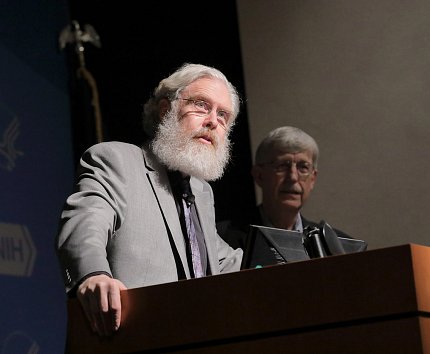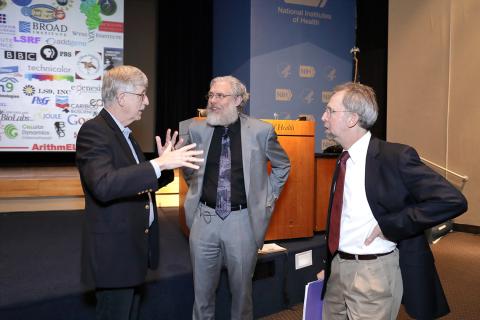Church Describes Medical Potential of Gene Editing

Photo: Ernie Branson
The thought of transplanting animal organs into humans conjures up images of the chimera—the Greek mythological monster with a lion’s head and a goat’s body. While this extreme is a long way off, rapid progress in gene-editing techniques at the heart of realizing such a transplant hold promise for developing new diagnostics and therapies in the next few years.
Recently, genome sequencing and gene-editing techniques have become faster, more accurate and cheaper thanks to the innovations of investigators such as Dr. George Church, who recently delivered the Marshall Nirenberg Lecture in Masur Auditorium.
“The thing that’s significant here is that we’re not just reading genes and their 64 types of triplet codons, which comprise the genetic code, but we’re also now writing them and can do radical recoding,” said Church, professor of genetics, health sciences and technology at Harvard University and director, Harvard-NHGRI Center of Excellence in Genomic Science.
The ability to alter genes offers the potential to treat heart and organ failure, cancer and many inherited conditions. The reason it’s possible to read whole genomes and write them on the billion base pair scale is due to such gene-editing tools as CRISPR—a tool Church’s lab helped invent that can delete, insert or alter genes—and novel sequencing methods such as fluorescent in situ RNA sequencing.
Another integral part of Church’s research is engineering cells to make them resistant to viruses. “It’s interesting, both practically and philosophically—you can make an organism resistant to all viruses in the world, even viruses you’ve never studied before, because they all expect a genetic code to be provided by the host, and we can change that radically without impacting the host,” he said.
All genetic organisms share a similar, though not identical, genetic code and all, so far, use all 64 codons (three base pairs of A, C, G, U that correspond to one of 20 specific amino acids) in some way. “We were surprised,” Church said, “that even changing one codon type was enough to make it resistant to most classes of viruses.”
Church’s lab is part of NIH’s BRAIN (Brain Research through Advancing Innovative Neurotechnologies) Initiative that seeks to analyze brain function with the goal of treating and preventing brain disorders. Astonishingly, Church and colleagues are also busy editing genetic code with the goal of building brains.
“We’re not just interested in making brains,” said Church. “We also want to make sure that when we make these organoids, they are physiologically reasonable and, if they’re not, we want to debug them with all the tools that we have.”

Photo: Ernie Branson
The idea of genetically modified humans may seem frightening, but as Church pointed out, there already are tens of thousands of them out there thanks to recent research trials for gene therapy.
“Many of the technologies I’ve brought up raise issues,” said Church. “We have a special responsibility to point out the downsides and the solutions to the downsides and then the problems that the solutions create, and further tweaks, which makes people nervous, but we need to do it.”
Gene therapy also holds the potential to alleviate sperm infertility, via stem cell clones, said Church. And, editing recessive genes may prevent early onset of genetic diseases such as Tay-Sachs.
“The irony is that germline therapy might reduce embryo harm rather than increase it,” said Church. “So we need to not be too dismissive and think carefully about this.”
Also foreboding to some is the idea of altering behavioral and cognitive traits. But altering genes can potentially be used to prevent Alzheimer’s and various disabilities, Church said.
Another type of genome engineering, RNA-guided gene drives, is under testing for controlling vector-borne disease. This could have global public health implications, particularly in developing countries that cannot afford medicines or easily distribute them in remote areas. Church’s lab has begun some experiments using CRISPR in malarial mosquitoes and to immunize animal reservoirs.
Dozens of gene therapies are now in veterinary clinical trials that could lead to human therapeutics, said Church. Pigs would be model candidates as their organs most closely resemble the shape and size of human organs. But a longstanding concern has been the potential for human recipients to contract porcine endogenous retroviruses (PERVs). Church’s lab, using CRISPR on these genes in 14 days, knocked out 62 PERVs at once—followed now by 45 genes involved in immune rejection and clotting.
With progress in gene therapy comes a host of biosafety, ethical and legal concerns. As these issues are debated, the words of the late Nobel laureate Dr. Marshall Nirenberg still ring true. In a 1967 editorial published in Science, he wrote: “When man becomes capable of instructing his own cells, he must refrain from doing so until he has sufficient wisdom to use this knowledge for the benefit of mankind.”
